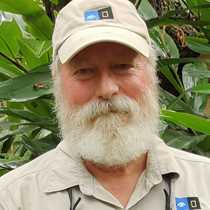Alphonse Group, Seychelles
We spent the entire day exploring the Alphonse Archipelago, a group of coral atolls in the southern region of the Seychelles. Expedition Leader Tim Soper found a great place for us to spend time both above and below sea level, starting with an early morning landing on St. Francois Island. Coming ashore over shallow sand flats onto a sparkling white sand beach just after sunrise was a great way to start the day.
St. Francois Island proved to be perfect for us, because it is has never been inhabited by people and was exactly what we would expect an island paradise to be. The island has been spared human development, so the vegetation is totally wild…there are no cleared areas, no coconut plantations, and no introduced ornamental plants. We found what would have to be described as a pristine Seychellois island. We could tell immediately that this island was special as there were countless fairy terns flying in tandem overhead and perched in the casuarina trees (see left image above), as well as dozens of grey herons feeding in the shallows in the interior of the island. As the day warmed up, the island’s frigate birds spiraled high up into the sky and disappeared into the expanse. The tide was dropping throughout our visit, and the exposed mud and sand flats became covered with hundreds of shorebirds (as well as more herons). People were amused by ghost crabs of all sizes skittering over the sand, as well as little hermit crabs in their amazingly diverse borrowed sea shells crawling along the high tide line among coral rubble, shells, and flotsam and jetsam. Actually, I can think of few things more fun than beachcombing, just as the hermit crabs were doing. When we walked into the shady interior of the island, we encountered even more hermit crabs gathered among the bases of the casuarina tree trunks. And, let’s not forget the hundreds of hand-sized red mangrove crabs foraging around the shallow, muddy, hidden lagoon located in the middle of the island. We would never find such a diversity and abundance of species on an inhabited island.
By mid-morning, most of us were in the water snorkeling or SCUBA diving along the outer edge of St. Francois Island’s surrounding coral reef structure. The current was quite strong at this state of the tide, so most snorkelers opted to be dropped in the water upstream of the anchored platform in order to enjoy an easier drift snorkel back to the platform. It was a delightful way to enjoy the rich fish fauna found on this reef.
In the early afternoon, we moved the ship a short distance to nearby Bijoutier Island, which is part of the same atoll system, and offered more water activities. This time, however, in addition to offering snorkeling and SCUBA diving, we got the glass-bottom Zodiac out for some ‘dry reef expeditions’ (see right image above). Everyone saw lots of fish, both small and large (including some enormous Napoleon wrasses), corals, and carpets of sea grass, but I think most people were infatuated with the sea turtles. Two species were encountered here…green sea turtles and hawksbill sea turtles, and they seemed more approachable than what we have experienced near inhabited islands.
Bijoutier Island was beckoning us during the afternoon, because it appears like one of those classic deserted islands we have all seen in movies and cartoons. It is small, but it contains an impressive amount of very green vegetation. The tide had risen enough by late afternoon for us to get over the surrounding reef flat and reach the island, where we made a Zodiac landing on yet another beautiful, footprint-free white sand beach. Hotel Manager Patrik Svardmir and his gang greeted us with sundowners upon arrival and we spent the next hour or so relaxing on the beach or walking completely around the island as the sun set behind a magnificent cloud-filled horizon.
When we gathered for our nightly Recap before a slightly later than normal dinner, everyone agreed we had used our time today to the absolute fullest. Yes, it was another very fulfilling day.




